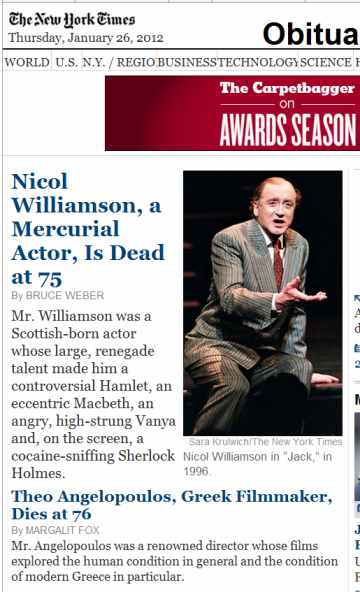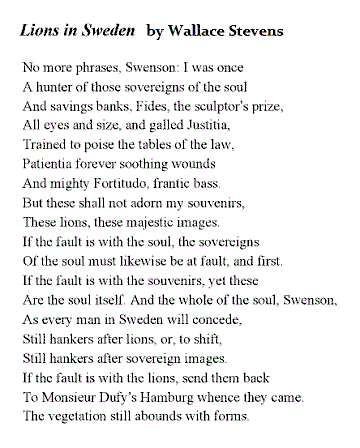Tuesday, January 31, 2012
|
"… a finite set with n elements
is sometimes called an n-set …."
Tesseract formed from a 4-set—


The same 16 subsets or points can
be arranged in a 4×4 array that has,
when the array's opposite edges are
joined together, the same adjacencies
as those of the above tesseract.
"There is such a thing as a 4-set."
— Saying adapted from a novel
|
Update of August 12, 2012:
Figures like the above, with adjacent vertices differing in only one coordinate,
appear in a 1950 paper of H. S. M. Coxeter—

Comments Off on Tesseract
Monday, January 30, 2012
The following passage by Tolkien was suggested by a copy of next Sunday's New York Times Book Review that arrived in the mail today. (See Orson Scott Card's remarks on page 26— "Uncle Orson"— and the Review 's concluding essay "Grand Allusion.")
"Lastly, tengwesta [system or code of signs] has also become an impediment. It is in Incarnates clearer and more precise than their direct reception of thought. By it also they can communicate easily with others, when no strength is added to their thought: as, for example, when strangers first meet. And, as we have seen, the use of 'language' soon becomes habitual, so that the practice of ósanwe (interchange of thought) is neglected and becomes more difficult. Thus we see that the Incarnate tend more and more to use or to endeavour to use ósanwe only in great need and urgency, and especially when lambe is unavailing. As when the voice cannot be heard, which comes most often because of distance. For distance in itself offers no impediment whatever to ósanwe . But those who by affinity might well use ósanwe will use lambe when in proximity, by habit or preference. Yet we may mark also how the 'affine' may more quickly understand the lambe that they use between them, and indeed all that they would say is not put into words. With fewer words they come swifter to a better understanding. There can be no doubt that here ósanwe is also often taking place; for the will to converse in lambe is a will to communicate thought, and lays the minds open. It may be, of course, that the two that converse know already part of the matter and the thought of the other upon it, so that only allusions dark to the stranger need be made; but this is not always so. The affine** will reach an understanding more swiftly than strangers upon matters that neither have before discussed, and they will more quickly perceive the import of words that, however numerous, well-chosen, and precise, must remain inadequate."
* "If a poem catches a student's interest at all, he or she should damned well be able to look up an unfamiliar word in the dictionary…."
— Elizabeth Bishop, quoted in the essay "Grand Allusion" mentioned above. For a brief dictionary of most of the unfamiliar words in this post's title and in the above passage, see Vinyar Tengwar 39 (July 1998). This is copyrighted but freely available on the Web.
** The word "affine" has connotations not intended by Tolkien. See that word in this journal. See also page 5 of next Sunday's Times Book Review , which contains a full-page ad for the 50th anniversary edition of A Wrinkle in Time . "There is such a thing as a tesseract."
Comments Off on Enda’s Game*
Sunday, January 29, 2012
Weblog posts of two prominent mathematicians today discussed
what appears to be a revolution inspired by the business practices
of some commercial publishers of mathematics.
See Gowers and Cameron.
My own concern is more with the so-called "Non-Euclidean Revolution"
described by Richard Trudeau in a book of that title (Birkhäuser, 1987).
A 1976 document relevant to the concerns in the Trudeau book—

Though not as well known as another document discussing
"self-evident" truths, Cameron's remarks are also of some
philosophical interest.
They apply to finite geometry, a topic unknown to Euclid,
but nevertheless of considerable significance for the foundations
of mathematics.
"The hand of the creative artist, laid upon the major premise,
rocks the foundations of the world." — Dorothy Sayers
Comments Off on Declarations
Beach with Palms
The following images were suggested by the
"other things" link in yesterday's "287501346" post.
From June 10, 2008—
Two frames from the Jodie Foster film "Contact"—
See Storyline and Time Fold.
Comments Off on Sunday School
Saturday, January 28, 2012

The twin topics of autism and of narrowing definitions
suggested the following remarks.
The mystical number "318" in the pilot episode
of Kiefer Sutherland's new series about autism, "Touch,"
is so small that it can easily apply (as the pilot
illustrated) to many different things: a date, a
time, a bus number, an address, etc.
The last 3/18 Log24 post— Defining Configurations—
led, after a false start and some further research,
to the writing of the webpage Configurations and Squares.
An image from that page—

Interpreting this, in an autistic manner, as the number
287501346 lets us search for more specific items
than those labeled simply 318.
The search yields, among other things, an offer of
Night Magic Cologne (unsold)—

For further mystery and magic, see, from the date
the Night Magic offer closed— May 8, 2010— "A Better Story."
See also the next day's followup, "The Ninth Gate."
Comments Off on The Sweet Smell of Avon
Friday, January 27, 2012


See also the links at the end of this morning's post.
Comments Off on Totentanz
Comments Off on Narrative
Princeton University Press on a book it will publish in March—
Circles Disturbed: The Interplay of Mathematics and Narrative
"Circles Disturbed brings together important thinkers in mathematics, history, and philosophy to explore the relationship between mathematics and narrative. The book's title recalls the last words of the great Greek mathematician Archimedes before he was slain by a Roman soldier— 'Don't disturb my circles'— words that seem to refer to two radically different concerns: that of the practical person living in the concrete world of reality, and that of the theoretician lost in a world of abstraction. Stories and theorems are, in a sense, the natural languages of these two worlds–stories representing the way we act and interact, and theorems giving us pure thought, distilled from the hustle and bustle of reality. Yet, though the voices of stories and theorems seem totally different, they share profound connections and similarities."
Timeline of the Marvel Cinematic Universe — Norway, March 1942—
"The Red Skull finds the Tesseract, a cube of strange power,
said to be the jewel of Odin’s treasure room, in Tonsberg Norway.
(Captain America: The First Avenger)"
Tesseracts Disturbed — (Click to enlarge)

Detail of Tesseracts Disturbed —

Narrative of the detail—
See Tesseract in this journal and Norway, May 2010—
The Oslo Version and Annals of Conceptual Art.
"Oh, what a tangled web we weave…"
Comments Off on Mathematics and Narrative (continued)
Thursday, January 26, 2012
"Something is happening to our town."
— Mayor of Pleasantville

Related material— Alicia Keys's birthday,
the ending of Midnight in Paris , and Rocket Billie.
See also a Sinatra song uploaded on this date
(Paul Newman's birthday) last year.
Comments Off on Change Illustrated

"You have a clear and lively voice."
— Midnight in Paris
Related material— Today's previous post.
Comments Off on Found in Space
 Dick Tufeld, Robot Voice in TV’s ‘Lost in Space,’ Dies at 85
Dick Tufeld, Robot Voice in TV’s ‘Lost in Space,’ Dies at 85
Wed Jan 25, 2012 23:42 from NYT Obituaries By Bruce Weber
"Mr. Tufeld possessed one of Hollywood’s most often-heard
disembodied voices, especially from the 1950s through the 1970s."
In memoriam— A link from the date of Tufeld's death
Comments Off on Lamedvavnik
Comments Off on After Midnight
Wednesday, January 25, 2012
ANY CHARACTER HERE
| BOOKS OF THE TIMES
HOW IT ALL BEGAN
By Penelope Lively
229 pages. Viking. $26.95.
Review by Michiko Kakutani
in The New York Times ,
online Jan. 23, 2012
As a historian, Henry acknowledges that he has “a soft spot for what is known as the Cleopatra’s nose theory of history— the proposal that had the nose of Cleopatra been an inch longer, the fortunes of Rome would have been different.” It’s a bit of a reductio ad absurdum, he admits, but nonetheless “a reference to random causality that makes a lot of sense when we think about the erratic sequence of events that we call history.”
What Ms. Lively has done in this captivating volume is to use all her copious storytelling gifts to show how a similar kind of random causality rules individual lives, how one unlucky event can set off unexpected chain reactions, how the so-called butterfly effect— whereby the flapping of a tiny butterfly’s wings can supposedly lead to a huge storm elsewhere in the world— ripples through the ebb and flow of daily life. |
Rhetorical question—
"Why walk when you can fly?"
— Mary Chapin Carpenter
Rhetorical answer—
Two excerpts from a webpage on random walks—
A drunk man will find his way home,
but a drunk bird may get lost forever.
— Shizuo Kakutani
Now we move to a larger city…

Comments Off on A Larger City
Happy birthday to…


Comments Off on State of a Nation
Tuesday, January 24, 2012
From Labyrinth of the Line (March 2, 2011)—
"… construct the Golay code by taking the 24 points
to be the points of the projective line F23 ∪ {∞}…."
— Robert A. Wilson
A simpler projective line— a Galois geometry
model of the line F2 ∪ {∞}—

Here we may consider ∞ to be modeled*
by the third square above— the Galois window .
* Update of about 1 AM Jan. 25, 2012—
This infinity-modeling is of course a poetic conceit,
not to be taken too seriously. For a serious
discussion of points at infinity and finite fields,
see (for instance) Daniel Bump's "The Group GL(2)."
Comments Off on The Infinity Point
"Debates about canonicity have been raging in my field
(literary studies) for as long as the field has been
around. Who's in? Who's out? How do we decide?"
— Stephen Ramsay, "The Hermeneutics of Screwing Around"
An example of canonicity in geometry—
"There are eight heptads of 7 mutually azygetic screws, each consisting of the screws having a fixed subscript (from 0 to 7) in common. The transformations of LF(4,2) correspond in a one-to-one manner with the even permutations on these heptads, and this establishes the isomorphism of LF(4,2) and A8. The 35 lines in S3 correspond uniquely to the separations of the eight heptads into two complementary sets of 4…."
— J.S. Frame, 1955 review of a 1954 paper by W.L. Edge,
"The Geometry of the Linear Fractional Group LF(4,2)"
Thanks for the Ramsay link are due to Stanley Fish
(last evening's online New York Times ).
For further details, see The Galois Tesseract.
Comments Off on The Screwing
Monday, January 23, 2012
(Continued)
J. H. Conway in 1971 discussed the role of an elementary abelian group
of order 16 in the Mathieu group M24. His approach at that time was
purely algebraic, not geometric—
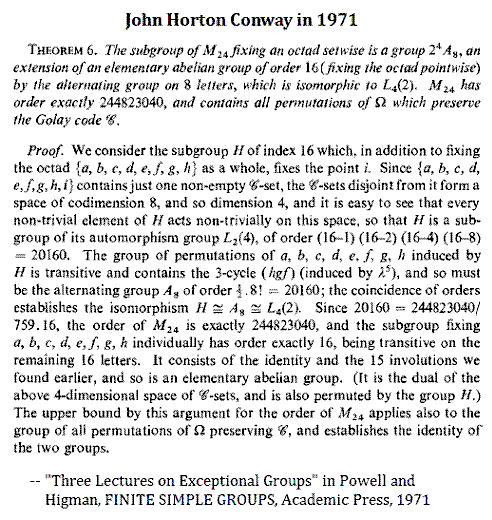
For earlier (and later) discussions of the geometry (not the algebra )
of that order-16 group (i.e., the group of translations of the affine space
of 4 dimensions over the 2-element field), see The Galois Tesseract.
Comments Off on How It Works
"Design is how it works." —Steve Jobs
Website logo—

Screenshot from How Stuff Works—


(Click image for details.)
From "A Device Worthy of a Gothic Novel,"
Chapter XVI of The Club Dumas,
by Arturo Perez-Reverte (1993),
Vintage International, April 1998….
the basis of the 1999 Roman Polanski film
The Ninth Gate —
Aren't you going to give me a document to sign?"
"A document?"
"Yes. It used to be called a pact. Now it would be a contract
with lots of small print, wouldn't it? 'In the event of litigation,
the parties are to submit to the jurisdiction of the courts of…'
That's a funny thing. I wonder which court covers this."
Comments Off on How Stuff Works
"Yo sé de un laberinto griego que es una línea única, recta."
—Borges, "La Muerte y la Brújula"
"I know of one Greek labyrinth which is a single straight line."
—Borges, "Death and the Compass"
Comments Off on Labyrinth
Sunday, January 22, 2012
Comments Off on Souvenir*
In China, the Year of the Dragon
has now begun. See Holy Field
in this journal.
Comments Off on Year of the Dragon
See Metamagical Themas —

— as well as the pound sign, alias hash .
Comments Off on Pound Sign


"The Cardinal seemed a little preoccupied today."
The New Yorker , May 13, 2002
Comments Off on Egress
An image suggested by a book at
Princeton University Press—
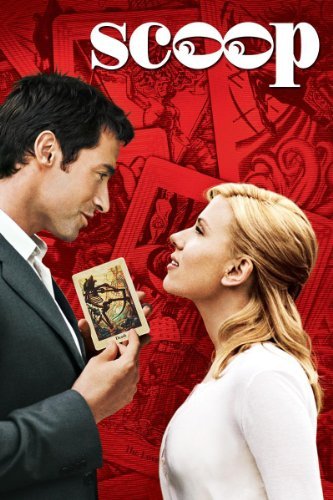
Click image for details.
See also a somewhat deeper book from Princeton.
Comments Off on Card Trick
Kindergarten Theology
(Log24, St. Bridget's Day, 2008)
Comments Off on Sermon
(Backstory— Presbyterian in this journal)
Princeton University Press on a book it will publish in March—
Circles Disturbed brings together important thinkers in mathematics, history, and philosophy to explore the relationship between mathematics and narrative. The book's title recalls the last words of the great Greek mathematician Archimedes before he was slain by a Roman soldier–"Don't disturb my circles"–words that seem to refer to two radically different concerns: that of the practical person living in the concrete world of reality, and that of the theoretician lost in a world of abstraction. Stories and theorems are, in a sense, the natural languages of these two worlds–stories representing the way we act and interact, and theorems giving us pure thought, distilled from the hustle and bustle of reality. Yet, though the voices of stories and theorems seem totally different, they share profound connections and similarities.
Exercise— Discuss the above paragraph's vulgarity.
Discuss also the more robust vulgarity of Marvel Entertainment…
Context— "Marvel" in this journal, and The Cosmic Cube.
Comments Off on The Presbyterian Exorcist
Saturday, January 21, 2012
(Continued)
Blame It on Trajan
Wikipedia on the 2008 film The Oxford Murders—


Christmas Eve image search
suggested by Stevens's phrase
"diamond globe."
(Larger version: 2 MB)
Comments Off on The Oxford Murders
Friday, January 20, 2012
(Continued from November 12, 2005 and June 7, 2011)
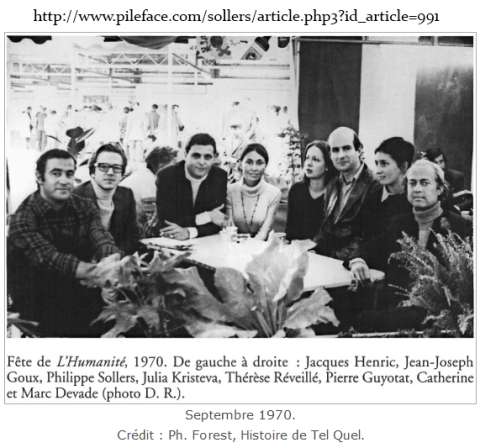
Related material— "Labyrinth," a fiction
by the late Roberto Bolaño
in the current New Yorker —
"There's no photo credit."
Comments Off on Cock Tale
"The 'one' with whom the reader has identified himself
has now become 'the listener, who listens in the snow';
he has become the snow man, and he knows winter
with a mind of winter, knows it in its strictest reality,
stripped of all imagination and human feeling.
But at that point when he sees the winter scene
reduced to absolute fact, as the object not of the mind,
but of the perfect perceptual eye that sees
'nothing that is not there,' then the scene,
devoid of its imaginative correspondences,
has become 'the nothing that is.'"
—Robert Pack, Wallace Stevens:
An Approach to His Poetry and Thought.
New Brunswick: Rutgers UP, 1958.

Comments Off on The Nothing That Is
| Saturday, November 12, 2005
— m759 @ 8:00 PM
(continued)

“… problems are the poetry of chess.
They demand from the composer
the same virtues that characterize
all worthwhile art:
originality, invention,
harmony, conciseness,
complexity, and
splendid insincerity.”
—Vladimir Nabokov
|
Comments Off on Chess
"If the fault is with the soul, the sovereigns
Of the soul must likewise be at fault, and first.
If the fault is with the souvenirs, yet these
Are the soul itself. And the whole of the soul, Swenson,
As every man in Sweden will concede,
Still hankers after lions, or, to shift,
Still hankers after sovereign images."
— Wallace Stevens
"Friday night and the lights are low"
— ABBA
See also American Music Award.
Comments Off on Soul Souvenirs
(Continued)
See "harmonic analysis" in Mathematical Imagery and elsewhere in this journal.
Comments Off on Brightness at Noon
Comments Off on Poetry and Thought*
Thursday, January 19, 2012

From the Crafoord Prize website—

Related meta -mathematical image from Diamond Theory—

Mathematical image related to combinatorics—

See also permutahedron in this journal.
Comments Off on Mathematical Imagery
Those impressed by George Steiner's remark on Hegel in the previous post may consult…
(Click to enlarge.)

(The Christian Examiner. Volume LXXX. New Series, Volume I. January, March, May, 1866.
New York: James Miller, Publisher, 522, Broadway. Boston: Walker, Fuller, & Co.
No. CCLIV, Art. IV.– THE SECRET OF HEGEL.
By C. C. Everett, pp. 196-207.
A review of…
The Secret of Hegel, being the Hegelian System in Origin, Principle, Form, and Matter.
By James Hutchinson Sterling. In two volumes.
London: Longman, Green, Longman, Roberts, & Green. 1865. 8vo, 2 vols.)
On Hegel, from the review—
"He starts not from the beginning, but from the heart, of the world.
There never was a time when this pure Being— which, in its
undivided absoluteness, is indistinguishable from nothing;
as pure, unbroken light is indistinguishable from darkness—
was by itself alone; but this absolute Being is yet the foundation
and the groundwork of whatever is."
For more on Hegel's logic, see Marxists.org.
See also Steiner on chess and Lenin in The New Yorker
(September 7, 1968, page 133).
Comments Off on Hegel
Perception vs. Inception
Question—
"Where philosophy and literature mesh, where they are litigious toward one another in form or matter, these echoes of origin can be heard. The poetic genius of abstract thought is lit, is made audible. Argument, even analytic, has its drumbeat. It is made ode. What voices the closing movements of Hegel’s Phenomenology better than Edith Piaf’s non de non , a twofold negation which Hegel would have prized?
This essay is an attempt to listen more closely."
— George Steiner, The Poetry of Thought
Answer—
Edith Piaf's rien de rien . See also Is Nothing Sacred?
Comments Off on ’Ceptions
MathWorld.Wolfram.com has an article titled "Square-Triangle Theorem."
An article of my own, whose HTML title was previously "Triangles are Square," has been retitled accordingly.
Comments Off on Square Triangles
Comments Off on What Rough Beast
Wednesday, January 18, 2012
Comments Off on For Esther
Tuesday, January 17, 2012
In memory of Bach interpreter
Gustav Leonhardt —

Augenmusik
Comments Off on Augenmusik
A search for khora + tao yields a paper on Derrida—


A check of the above date— Nov. 18, 2010— yields…
| Thursday, November 18, 2010
Frontiers of Speculation
m759 @ 8:02 AM
Peter Woit has a post on Scientific American 's new Garrett Lisi article, "A Geometric Theory of Everything."
The Scientific American subtitle is "Deep down, the particles and forces of the universe are a manifestation of exquisite geometry."
See also Rhetoric (Nov. 4, 2010) and Exquisite Geometries (May 19, 2009).
|
Related material on the temptation of physics
for a pure mathematician—
This morning's post on khora and Cardinal Manning, and,
from Hawking's birthday this year, Big Apple.
Within this post, by leading us to the apple,
Derrida as usual plays the role of Serpent.
Comments Off on Khora as Synchronicity
A weblog post from Saturday, Jan. 14, 2012—
"Today is the 120th anniversary of Cardinal Henry Edward Manning's death."
— A Reluctant Sinner (Thanks to Andrew Cusack for the link.)
If Manning is a saint, then Saturday was his feast day.
Some background— Manning in this journal.
See also Saturday's Derrida at Villanova. The link there to
previous posts on that topic leads to a post on Derrida's promotion
of his neologism différance as a version of Plato's khôra.
I prefer Manning's discussion of a closely related concept,
the scholastic philosophers' materia prima .
See Hugh R. King's 1956 paper sneering at the scholastics'
concept, and Heisenberg's much better-informed remarks
on the related concept of potentia —

For a related fictional account of a religious quest for "possibilities"
and "excluded middles" between "zeroes and ones," see
Ingraffia on The Crying of Lot 49 .
Comments Off on Manning and Khora
Monday, January 16, 2012
Thursday's post Triangles Are Square posed the problem of
finding "natural" maps from the 16 subsquares of a 4×4 square
to the 16 equilateral subtriangles of an edge-4 equilateral triangle.

Here is a trial solution of the inverse problem—
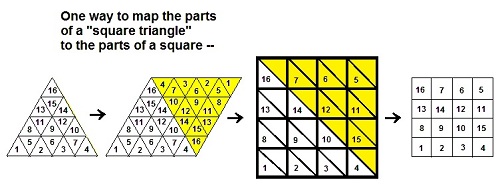
(Click for larger version.)
Exercise— Devise a test for "naturality" of
such mappings and apply it to the above.
Comments Off on Mapping Problem
Sunday, January 15, 2012
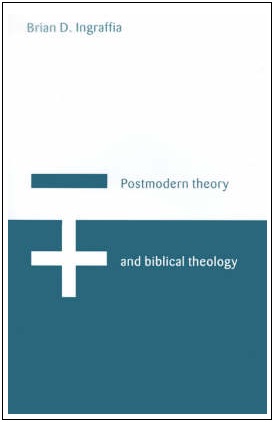
"Accentuate the Positive."
— Clint Eastwood, soundtrack album for
"Midnight in the Garden of Good and Evil."
Comments Off on Sermon
Headline from yesterday evening's New York Times obituaries—
Frederica Sagor Maas, Silent-Era Scriptwriter, Dies at 111.
For Maas… Past Tense (Jan. 7, 2012) and its link to Dogma.
Related material—
Last night's SNL, this morning's Entertainment Break,
and — in the context of Dogma — Catholics Believe.
From an LA Times story about Maas on January 7—
"Many of the screenplays she and her husband wrote between 1938 and 1950 were never produced. Hopeless, humiliated and having little money, the couple drove to a hilltop overlooking Hollywood with the intention of committing suicide in their Plymouth. Clutching each other, they started sobbing and realized that 'none of these things mattered. We had each other,' wrote Maas…."
Comments Off on Requiem Maas

Related material– Saturday night's Derrida at Villanova and Villanueva.
Comments Off on Entertainment Break
Identity Crisis— Or, Tilting at Whirligigs
Comments Off on Sunday School
Saturday, January 14, 2012
"As Derrida said at Villanova,
"We wait for something we would not like to wait for.
That is another name for death."
— Brian D. Ingraffia, "Is the Postmodern Post-Secular?,"
p. 50 in Postmodern Philosophy and Christian Thought ,
ed. by Merold Westphal, Indiana University Press, 1999, pp. 44-68
See also Derrida at Villanova in this journal.
The link to Ingraffia's remarks was suggested by
this evening's New York Times obituaries—

Comments Off on Derrida at Villanova
Detail of Sylvie Donmoyer picture discussed
here on January 10—

The "13" tile may refer to the 13 symmetry axes
in the 3x3x3 Galois cube, or the corresponding
13 planes through the center in that cube. (See
this morning's post and Cubist Geometries.)
Comments Off on Defining Form (continued)
(Continued)
The following is adapted from a 2011 post—

* The title, that of a Fritz Leiber story, is suggested by
the above picture of the symmetry axes of the square.
Click "Continued" above for further details. See also
last Wednesday's Cuber.
Comments Off on Damnation Morning*
Friday, January 13, 2012

Wiener on Paley—
… he was already recognised as the ablest of the group of young English mathematicians who have been inspired by the genius of G H Hardy and J E Littlewood. In a group notable for its brilliant technique, no one had developed this technique to a higher degree than Paley. Nevertheless he should not be though of primarily as a technician, for with this ability he combined creative power of the first order. As he himself was wont to say, technique without 'rugger tactics' will not get one far, and these rugger tactics he practised to a degree that was characteristic of his forthright and vigorous nature.
The Telegraph today on British mystery author Reginald Hill—
"After National Service between 1955 and 1957,
he went up on a scholarship to St Catherine’s College, Oxford,
where he played rugby…."
Further details—

"Unsheathe your dagger definitions." — James Joyce
Some context— St. Catherine in this journal and her feast day last year.
Comments Off on Mysteries of Faith
Click logos for related persons.


Some related news.
Background from this journal—
Collegiality, That Hideous Strength , and The Oxford Murders .
See also…
"The heart of the book is the conveying of a meaningful understanding
of where mathematical results originated…."
Comments Off on Logos
Thursday, January 12, 2012
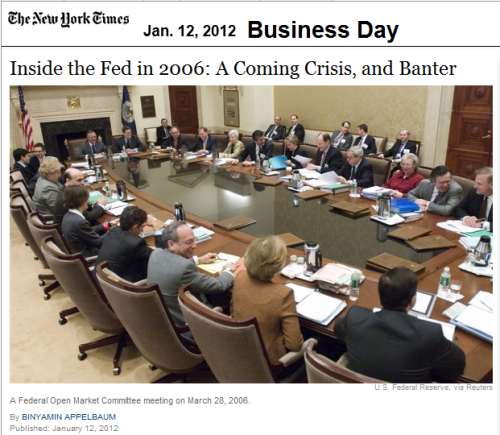
"The transcripts of the 2006 meetings, released after a standard five-year delay,
clearly show some of the nation’s pre-eminent economic minds did not fully understand
the basic mechanics of the economy that they were charged with supervising."
— Binyamin Appelbaum in the Jan. 12 online New York Times
Academics may recall other examples of comfortably ignorant collegiality.
Comments Off on Collegiality in Action
Coming across John H. Conway's 1991*
pinwheel triangle decomposition this morning—
— suggested a review of a triangle decomposition result from 1984:

Figure A
(Click the below image to enlarge.)

The above 1985 note immediately suggests a problem—
What mappings of a square with c 2 congruent parts
to a triangle with c 2 congruent parts are "natural"?**
(In Figure A above, whether the 322,560 natural transformations
of the 16-part square map in any natural way to transformations
of the 16-part triangle is not immediately apparent.)
* Communicated to Charles Radin in January 1991. The Conway
decomposition may, of course, have been discovered much earlier.
** Update of Jan. 18, 2012— For a trial solution to the inverse
problem, see the "Triangles are Square" page at finitegeometry.org.
Comments Off on Triangles Are Square
Wednesday, January 11, 2012
"Examples galore of this feeling must have arisen in the minds of the people who extended the Magic Cube concept to other polyhedra, other dimensions, other ways of slicing. And once you have made or acquired a new 'cube'… you will want to know how to export a known algorithm , broken up into its fundamental operators , from a familiar cube. What is the essence of each operator? One senses a deep invariant lying somehow 'down underneath' it all, something that one can’t quite verbalize but that one recognizes so clearly and unmistakably in each new example, even though that example might violate some feature one had thought necessary up to that very moment. In fact, sometimes that violation is what makes you sure you’re seeing the same thing , because it reveals slippabilities you hadn’t sensed up till that time….
… example: There is clearly only one sensible 4 × 4 × 4 Magic Cube. It is the answer; it simply has the right spirit ."
— Douglas R. Hofstadter, 1985, Metamagical Themas: Questing for the Essence of Mind and Pattern (Kindle edition, locations 11557-11572)
See also Many Dimensions in this journal and Solomon's Cube.
Comments Off on Cuber
Tension in the Common Room—

In memory of population geneticist James F. Crow,
who died at 95 on January 4th.
Comments Off on Language Game
Tuesday, January 10, 2012
"'Interpenetration'" — Stanley Fish in yesterday evening's online New York Times
"You want Frye's with that?" — A recent humanities graduate


Comments Off on Frye’s
(Continued from Epiphany and from yesterday.)
Detail from the current American Mathematical Society homepage—
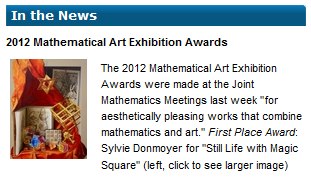
Further detail, with a comparison to Dürer’s magic square—
The three interpenetrating planes in the foreground of Donmoyer‘s picture
provide a clue to the structure of the the magic square array behind them.
Group the 16 elements of Donmoyer’s array into four 4-sets corresponding to the
four rows of Dürer’s square, and apply the 4-color decomposition theorem.
Note the symmetry of the set of 3 line diagrams that result.
Now consider the 4-sets 1-4, 5-8, 9-12, and 13-16, and note that these
occupy the same positions in the Donmoyer square that 4-sets of
like elements occupy in the diamond-puzzle figure below—

Thus the Donmoyer array also enjoys the structural symmetry,
invariant under 322,560 transformations, of the diamond-puzzle figure.
Just as the decomposition theorem’s interpenetrating lines explain the structure
of a 4×4 square , the foreground’s interpenetrating planes explain the structure
of a 2x2x2 cube .
For an application to theology, recall that interpenetration is a technical term
in that field, and see the following post from last year—
Comments Off on Defining Form
Monday, January 9, 2012
Yesterday's All About Eve post featured Pope John Paul II
with his close friend and confidant Jerzy Kluger.
Their counterparts Xavier and Magneto in the recent film
"X-Men: First Class," together with Catholic doctrine on telepathy,
suggest the following meditations.
Douglas Hofstadter on interpenetration—

— as well as Trinity in this journal.
First the punchline—

Then the joke.
Comments Off on M Theory
Sunday, January 8, 2012

“…the nonlinear characterization of Billy Pilgrim
emphasizes that he is not simply an established
identity who undergoes a series of changes but
all the different things he is at different times.”

This suggests that the above structure
be viewed as illustrating not eight parts
but rather 8! = 40,320 parts.

"The Cardinal seemed a little preoccupied today."
The New Yorker , May 13, 2002
See also a note of May 14 , 2002.
Comments Off on Big Apple
Literary symbolism, offered without comment—
Comments Off on All About Eve (continued)
Saturday, January 7, 2012
Today's Google Doodle for the 100th birthday of Charles Addams—

A doodle from this year's Feast of the Epiphany—

A doodle based on today's previous post and on a post for Twelfth Night, 2003—


Comments Off on Doodles
From a post that was written for Twelfth Night—
Bernhard Weiss on the philosophy of Michael Dummett—
" … debates about realism, that is, those debates that ask
whether or not one or another aspect of the world is independent
of the way we represent that aspect to ourselves. For example,
is there a realm of mathematical entities that exists fully formed
independently of our mathematical activity? Are there facts about
the past that our use of the past tense aims to capture?"
Yes and Yes.
See also The Whirligig of Time in this journal.
Comments Off on Past Tense
Comments Off on Number and Form
"Dreams are sleep's watchful brother, of death's fraternity,
heralds, watchmen of that coming night, and our attitude
toward them may be modeled upon Hades, receiving, hospitable,
yet relentlessly deepening, attuned to the nocturne, dusky, and
with a fearful cold intelligence that gives permanent shelter
in his house to the incurable conditions of human being."
— James Hillman, conclusion of
The Dream and the Underworld (Harper & Row, 1979)
In memory of Raymond Edward Alan Christopher Paley—
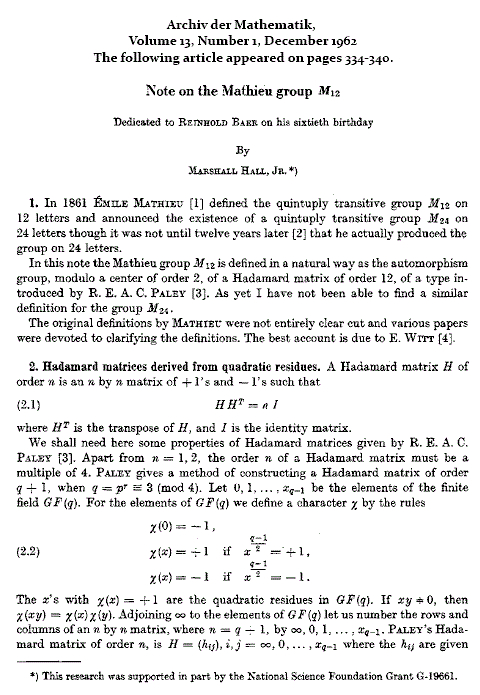
Related material— Mathieu Symmetry.
Comments Off on Fearful Cold Intelligence

… que cantaba el rey David.
Comments Off on Little Morning
Friday, January 6, 2012
An example for the Feast of the Epiphany*

For one approach to defining this form, see Diamond Star.
* And for Pomona College
Comments Off on Form

Some related resources from Malcolm Lowry—
"…his eyes ranged the Consul's books disposed quite neatly… on high shelves around the walls: Dogme et Ritual de la Haute Magie , Serpent and Siva Worship in Central America , there were two long shelves of this, together with the rusty leather bindings and frayed edges of the numerous cabbalistic and alchemical books, though some of them looked fairly new, like the Goetia of the Lemegaton of Solomon the King , probably they were treasures, but the rest were a heterogeneous collection…."
— Under the Volcano , Chapter VI
— and from Matilde Marcolli—
Seven books on analytical psychology
See also Marcolli in this morning's previous post, The Garden Path.
For the relevance of alchemy to form, see Alchemy in this journal.
Comments Off on Defining Form
"Not all those who have sought to decode the symbolism of the Tarot pack
have been occultists; some have been serious scholars…."
— Michael Dummett, The Game of Tarot , Ch. 20
“Eliot by his own admission took the ‘still point of the turning world’
in Burnt Norton from the Fool in Williams’s The Greater Trumps .”
— Humphrey Carpenter, The Inklings , Ballantine Books, 1981, p. 106
From a talk on April 16, 2010, in Cuernavaca—

Related material—

See also The Martial Art of Giving Talks.
(Thanks to Lieven Le Bruyn for his Twelfth Night post on this topic.)
Comments Off on The Garden Path
Thursday, January 5, 2012
"Publisher: Crown Archetype (November 1, 2011)"
— Amazon.com on Piper Laurie's new self-portrait
See also last year's For All Hallows Day and today's previous post.
Some context: "God's Girlfriend" in this journal
and "Shouts & Murmurs" in The New Yorker
of January 9th, 2012—
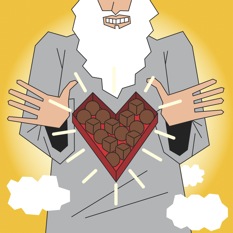
Life is like a box of chocolates.
ILLUSTRATION: Maximilian Bode
Comments Off on Crown Archetype
From a review of Truth and Other Enigmas , a book by the late Michael Dummett—
"… two issues stand out as central, recurring as they do in many of the
essays. One issue is the set of debates about realism, that is, those debates that ask
whether or not one or another aspect of the world is independent of the way we
represent that aspect to ourselves. For example, is there a realm of mathematical
entities that exists fully formed independently of our mathematical activity? Are
there facts about the past that our use of the past tense aims to capture? The other
issue is the view— which Dummett learns primarily from the later Wittgenstein—
that the meaning of an expression is fully determined by its use, by the way it
is employed by speakers. Much of his work consists in attempts to argue for this
thesis, to clarify its content and to work out its consequences. For Dummett one
of the most important consequences of the thesis concerns the realism debate and
for many other philosophers the prime importance of his work precisely consists
in this perception of a link between these two issues."
— Bernhard Weiss, pp. 104-125 in Central Works of Philosophy , Vol. 5,
ed. by John Shand, McGill-Queen's University Press, June 12, 2006
The above publication date (June 12, 2006) suggests a review of other
philosophical remarks related to that date. See …

For some more-personal remarks on Dummett, see yesterday afternoon's
"The Stone" weblog in The New York Times.
I caught the sudden look of some dead master….
— Four Quartets
Comments Off on Precisely
Wednesday, January 4, 2012
I revised the cubes image and added a new link to
an explanatory image in posts of Dec. 30 and Jan. 3
(and at finitegeometry.org). (The cubes now have
quaternion "i , j , k " labels and the cubes now
labeled "k " and "-k " were switched.)
I found some relevant remarks here and here.
Comments Off on Revision
Tuesday, January 3, 2012
"He had come a long way to this blue lawn,
and his dream must have seemed so close
that he could hardly fail to grasp it.
He did not know that it was already behind him,
somewhere back in that vast obscurity beyond the city,
where the dark fields of the republic rolled on under the night."
— The Great Gatsby

See also St. Andrew's Day, 2011, in this journal.
Comments Off on Dark Fields
In memory of artist Ronald Searle—

Searle reportedly died at 91 on December 30th.
From Log24 on that date—

Click the above image for some context.
Update of 9:29 PM EST Jan. 3, 2012—
|
Theorum
From RationalWiki
Theorum (rhymes with decorum, apparently) is a neologism proposed by Richard Dawkins in The Greatest Show on Earth to distinguish the scientific meaning of theory from the colloquial meaning. In most of the opening introduction to the show, he substitutes "theorum" for "theory" when referring to the major scientific theories such as evolution.
Problems with "theory"
Dawkins notes two general meanings for theory; the scientific one and the general sense that means a wild conjecture made up by someone as an explanation. The point of Dawkins inventing a new word is to get around the fact that the lay audience may not thoroughly understand what scientists mean when they say "theory of evolution". As many people see the phrase "I have a theory" as practically synonymous with "I have a wild guess I pulled out of my backside", there is often confusion about how thoroughly understood certain scientific ideas are. Hence the well known creationist argument that evolution is "just a theory" – and the often cited response of "but gravity is also just a theory".
To convey the special sense of thoroughness implied by the word theory in science, Dawkins borrowed the mathematical word "theorem". This is used to describe a well understood mathematical concept, for instance Pythagoras' Theorem regarding right angled triangles. However, Dawkins also wanted to avoid the absolute meaning of proof associated with that word, as used and understood by mathematicians. So he came up with something that looks like a spelling error. This would remove any person's emotional attachment or preconceptions of what the word "theory" means if it cropped up in the text of The Greatest Show on Earth , and so people would (in "theory ") have no other choice but to associate it with only the definition Dawkins gives.
This phrase has completely failed to catch on, that is, if Dawkins intended it to catch on rather than just be a device for use in The Greatest Show on Earth . When googled, Google will automatically correct the spelling to theorem instead, depriving this very page its rightful spot at the top of the results.
See also
|
Some backgound— In this journal, "Diamond Theory of Truth."
Comments Off on Theorum
Monday, January 2, 2012
An adaptation for the late Barbara Lea—
Man's spirit will be flesh-bound, when found at best,
But úncúmberèd: meadow-dówn is nót distréssed
For a ráinbow fóoting it nor shé for her bónes rísen.
— After Gerard Manley Hopkins, Society of Jesus
* "And I began to see things in a way that let me hold the world without me in it."
— Alice Sebold
Comments Off on The Lovely Bones*
Sunday, January 1, 2012
"… myths are stories, and like all narratives
they unravel through time, whereas grids
are not only spatial to start with,
they are visual structures that explicitly reject
a narrative or sequential reading of any kind."
— Rosalind Krauss in "Grids,"
October (Summer 1979), 9: 50-64.
Counterexample—

The Ninefold Square
See Coxeter and the Aleph and Ayn Sof—
Comments Off on Sunday Shul
(Continued)

Both Ears…

And the Tale…

For another version of the tale, click
the "Continued" link from last year's final post.
Comments Off on Times Square Church


















